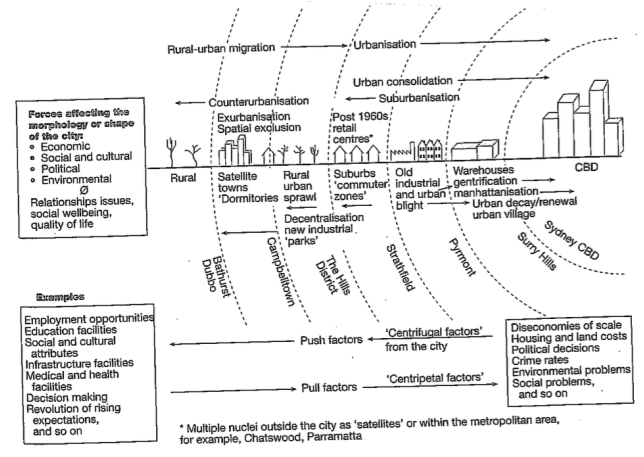|
Urban Dynamics are the forces that shape and reshape cities over time.
Urban dynamics can happen as gradual and natural processes or as coordinated government government actions.
| |||||||
Suburbanisation
"Previously rural urban fringes (or Greenfield areas) are developed into residential areas, which attract people from urban city living areas."
Suburbanisation has a range of environmental impacts arising from from land clearing, exponential infrastructure costs and increased transport emissions.
Suburbanisation has a range of environmental impacts arising from from land clearing, exponential infrastructure costs and increased transport emissions.
Exurbanisation
"A process whereby people, usually affluent, move from the city to rural areas but continue to maintain an urban way of life either through long distance commuting or technology."
This became known as "Sea Changing" or "Tree Changing". Exurbanisation relies on strong ICT linkages and transport connections.
This became known as "Sea Changing" or "Tree Changing". Exurbanisation relies on strong ICT linkages and transport connections.
Counterurbanisation
"A marked decline in the total population, or growth of the population, of large metropolitan areas and the subsequent growth of smaller urban centres at their expense — first identified in North America in the 1970s where counterurbanisation had replaced urbanisation as the dominant force shaping the nation’s settlement pattern."
Decentralisation
"The movement of people, commerce or industry out of a city’s centre either naturally or deliberately by government policy."
Decentralisation may also involve the creation of nodal points which decrease the importance of the CBD.
Decentralisation may also involve the creation of nodal points which decrease the importance of the CBD.
Urban decay
"Also called urban blight. Refers to an area that has become derelict or unwanted. This occurs at a neighbourhood scale and at city scale in “Brownfield” sites."
Urban decay often results from a change in industry types in a city or suburb. For example, the flight of the car industry in Detroit created mass unemployment in that city.
Urban decay often results from a change in industry types in a city or suburb. For example, the flight of the car industry in Detroit created mass unemployment in that city.
Urban renewal
"The redevelopment of an area that has undergone urban decay. This may occurs as a government lead, large scale redevelopment or a natural shift in desirability of an area."
Gentrification is a form of Urban renewal that sees the gradual increase in property prices and regeneration of real estate as residents with more capital purchase property in an area.
Gentrification is a form of Urban renewal that sees the gradual increase in property prices and regeneration of real estate as residents with more capital purchase property in an area.
Urban village
"Distinctive residential districts comprising a clustering of people with a common culture and forming an identifiable community."
One example of Urban Villages are the cultural enclaves that area often associated with migrant communities. Various lifestyle communities, such as the Gay Community, may form Urban Villages.
One example of Urban Villages are the cultural enclaves that area often associated with migrant communities. Various lifestyle communities, such as the Gay Community, may form Urban Villages.
Consolidation
"Increasing the density of use of existing urban infrastructure to reduce sprawl and increase efficient use of space. "
This is most commonly expressed as the replacement of free standing homes with apartment blocks.
This is most commonly expressed as the replacement of free standing homes with apartment blocks.
Spatial exclusion
"Restrictions in spatial access in urban areas for the defence of luxury lifestyles. Manifested in gated communities, walled estates and high security suburbs."
Spatial exclusion can occur at a variety of scales.
Spatial exclusion can occur at a variety of scales.
